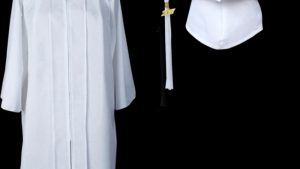
Cap and gown, a symbolic attire that holds immense significance in various stages of academic achievement. From the tender years of preschool to the pinnacle of earning a master’s degree, this timeless tradition marks the culmination of countless hours of determination, dedication, and perseverance. It is a sartorial emblem that unites graduates across generations, bridging the gap between fond memories and promising futures.
For preschoolers, donning a miniature cap and gown is a delightful rite of passage, embodying their first steps into the world of education. The adorable sight of these tiny graduates, their faces beaming with pride, reflects the innocence and wonder of these early academic milestones. Beyond its charm, this iconic ensemble instills in young hearts the seeds of ambition and a desire for knowledge, igniting a lifelong love for learning.
At the other end of the educational spectrum, we find master’s degree candidates eagerly awaiting their turn to walk across the stage, draped in the regalia that symbolizes their advanced expertise in their chosen field. The weight of the cap and gown is not merely physical; it carries the weight of years of scholarly inquiry, late nights of research and writing, and the pursuit of intellectual excellence. As these graduates move forward to embrace their future careers, the cap and gown serves as a tangible reminder of the immense dedication and sacrifice required to reach this pinnacle of academic accomplishment.
Whether worn by preschoolers or master’s degree candidates, the cap and gown transcend their physical presence, resonating with the essence of achievement, growth, and transformation. They embody the culmination of one chapter and the beginning of the next, capturing the spirit of perseverance and the promise of a brighter tomorrow. As we witness the melange of emotions during commencement ceremonies, we are reminded of the boundless potential of education and the enduring legacy of the cap and gown.
Preschool Cap and Gown: Significance and Symbolism
In the world of academia, the sight of little ones donning preschool cap and gown fills the air with an overwhelming sense of pride and achievement. Each year, these miniature graduates take their first steps towards a lifetime of learning, and the cap and gown they wear holds great significance and symbolism.
First and foremost, the preschool cap and gown serve as a visual representation of the successful completion of their early educational journey. These miniature versions of the traditional academic attire symbolize the achievement and personal growth these young pupils have experienced during their time in preschool.
Join Now
Beyond the academic aspect, there is also a sense of unity and belonging that comes with wearing the cap and gown. Dressed in identical attire, the preschool graduates become part of a collective whole, showcasing their dedication and commitment to education. It is a moment when individual accomplishments are celebrated alongside the achievements of peers, fostering a sense of camaraderie and shared success.
Moreover, the preschool cap and gown also act as a bridge, connecting these young learners to the tradition and legacy of education. By wearing the cap and gown, these preschoolers are introduced to the rituals and customs associated with graduation ceremonies, preparing them for the years to come as they advance through their academic journey.
In conclusion, the symbolism embedded in the preschool cap and gown goes beyond mere attire. It represents accomplishment, unity, and the continuity of education. As these young graduates proudly wear their caps and gowns, they embody the promise and potential of their future educational endeavors.
2. Master Degree Caps and Gowns: A Closer Look
Master degree caps and gowns hold a significant place in academia, symbolizing the culmination of years of hard work and dedication. These distinguished garments reflect the academic achievements of individuals who have attained a higher level of education. The cap, known as a mortarboard, and the gown are key elements in this revered tradition.
The mortarboard, a square-shaped cap with a flat top, is a timeless symbol of academic accomplishment. It is traditionally made from black fabric, adorned with a tassel that hangs from the topmost corner. The position of the tassel can vary, depending on the academic institution and the specific degree being conferred. Graduates proudly wear their mortarboards during commencement ceremonies, symbolizing their successful completion of advanced studies.
Accompanying the mortarboard is the distinguished gown, typically made of black fabric with intricate detailing that varies based on academic discipline and the level of degree being awarded. Master’s degree gowns are often distinguished by flared sleeves and additional decorative elements. The gown’s length and design may differ across universities, representing their unique traditions and heritage.
Master degree caps and gowns create a sense of unity and pride among graduates, as they symbolize the attainment of their advanced education. These iconic garments not only evoke a sense of accomplishment but also serve as a visual reminder of the academic journey embarked upon by those who wear them.
3. The Evolution of Academic Attire
The cap and gown, as we know it today, has undergone a fascinating evolution. Its significance and style have evolved alongside the academic world.
Initially, the concept of wearing academic attire can be traced back to medieval Europe. Scholars of the time wore long robes and hoods to protect themselves from the cold, damp conditions of the classrooms. These robes gradually became associated with the pursuit of knowledge and were seen as a symbol of scholarly achievement.
Over time, the adoption of academic attire spread to different levels of education. Preschools also embraced this tradition, introducing miniature versions of the cap and gown for their young graduates. The sight of adorable children proudly donning their tiny graduation robes creates cherished memories for both the children and their families.
Furthermore, academic attire took on new dimensions at the advanced education level. Master degree caps and gowns are characterized by their intricate design, reflecting the years of dedication and commitment required to obtain such a degree. These regal robes exude a sense of accomplishment and signify the mastery of a specific field of study.
In conclusion, the cap and gown have come a long way, from their humble origins as protective garments to their current status as powerful symbols of academic achievement. Whether it is the preschoolers’ adorable attire or the regal robes of master’s graduates, these garments hold deep significance for individuals and societies alike.
















